First, we have someone offering us to pay for it:
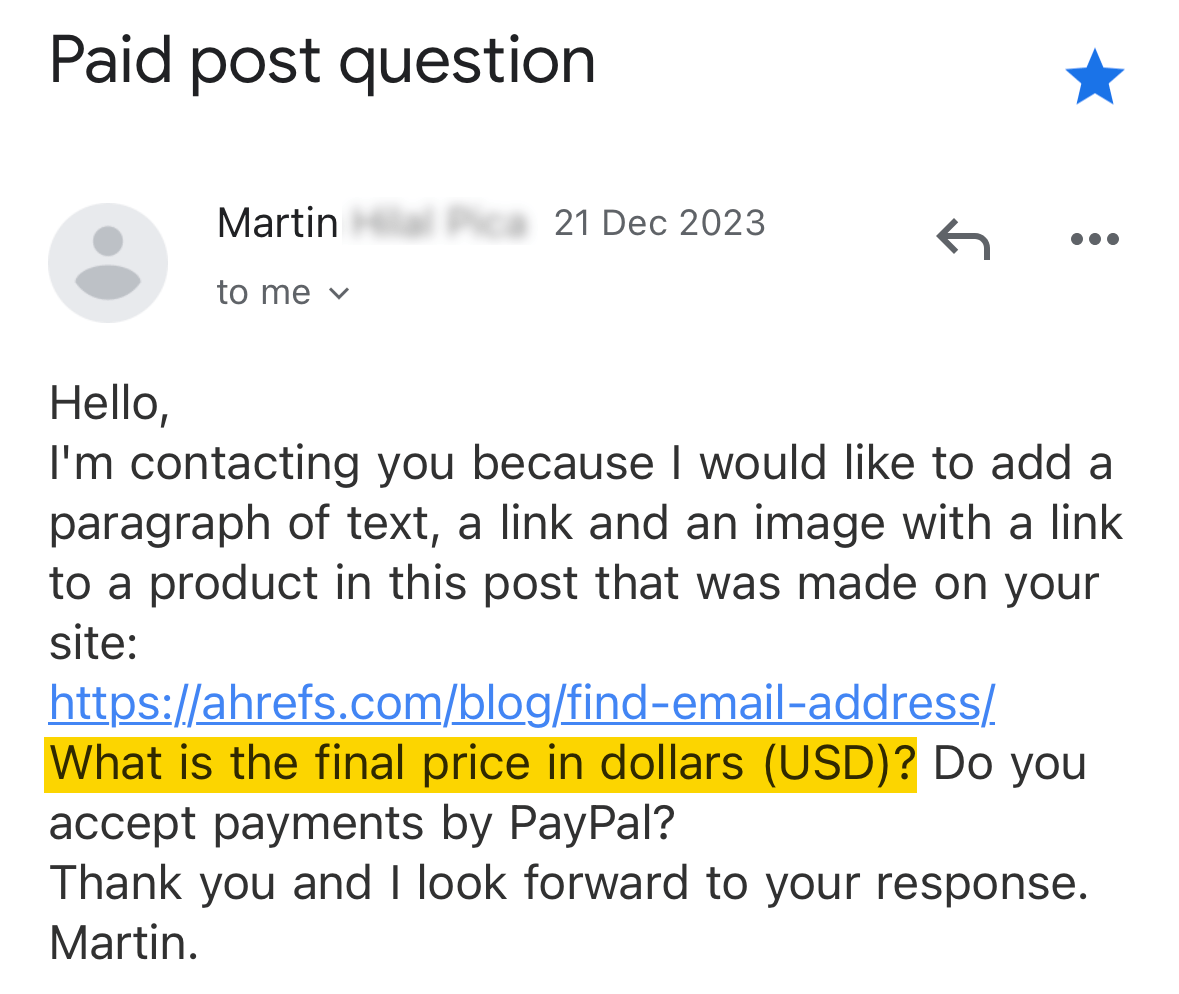
Then there’s someone else, framing their backlink request as a “guest post opportunity”:
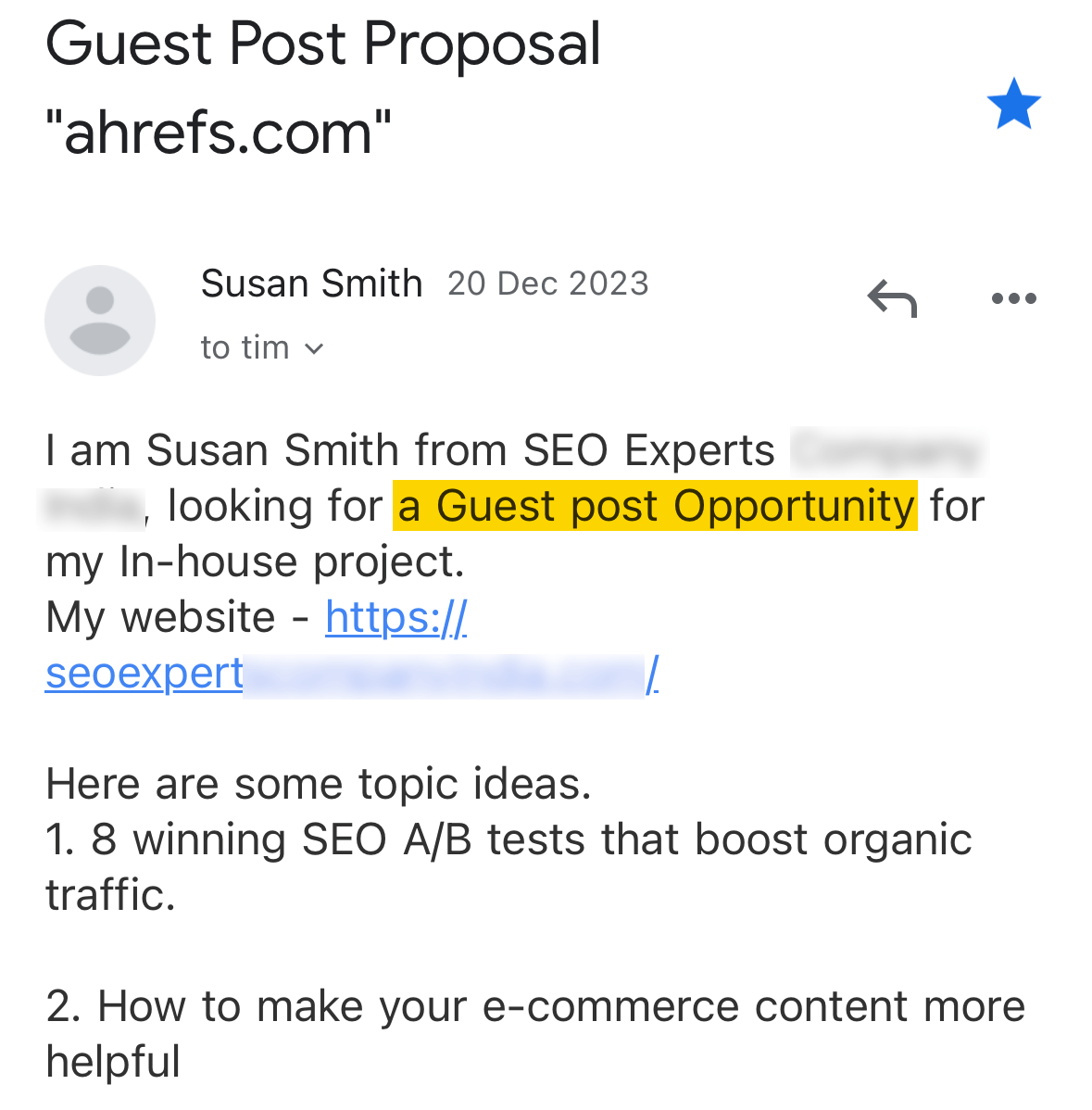
And finally, here’s the most professional one of the three. This email looks fairly well written, but in essence, it’s offering me a choice between a guest article, a link exchange, and some other form of collaboration (I wonder what could that be, hmmm?):
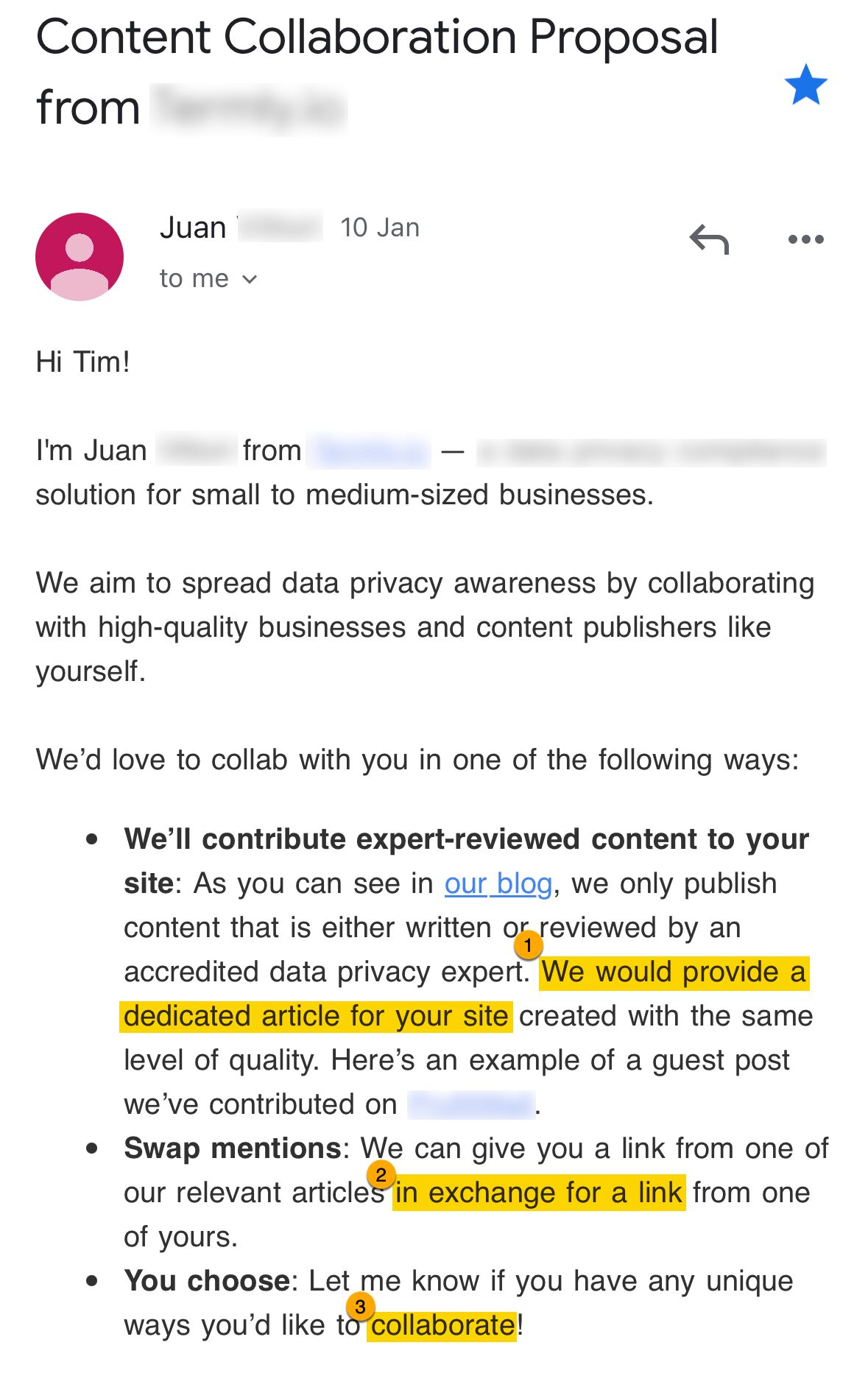
Bottomline: all these people are looking to get backlinks. And each of them is using a different link building strategy to achieve their goal.
But do any of these strategies actually work? And which of them is the most effective?
I know you want to build backlinks to your website. And I want to help you do that. But giving you yet another list with a dozen generic link building strategies won’t be of much help. Trust me. The strategies are secondary. What comes first is your understanding of why people link, and how to persuade them to link to you.
Here’s what you’re about to learn:
- How to drastically increase your chances of getting a link from someone.
- My takeaways from sending 111 outreach emails to get links to my article.
- How a marketing agency got a “followed” link from the very homepage of our website.
Sounds good? Then let’s dive in!
While I was working on our Beginner’s Guide To Link Building (which I highly recommend that you read, if you’re interested in this topic), I spoke to a few dozen link building practitioners with different backgrounds: marketing agency owners, affiliate marketers, in-house SEOs, freelancers.
And while picking their brain on how they’re building links I noticed a distinct pattern. All link building tactics and strategies actually fall into four very simple buckets: Add, Earn, Ask, Buy.
- Add—some websites allow their visitors to add links manually. (Like posting on a forum.)
- Earn—that’s when people link to you naturally, without being asked. (Which is the best case scenario.)
- Ask—this is when you reach out to a website owner and ask them for a link. (Like in the email screenshots above.)
- Buy—you can buy backlinks either directly from website owners or via a third party. (But that’s quite risky!)
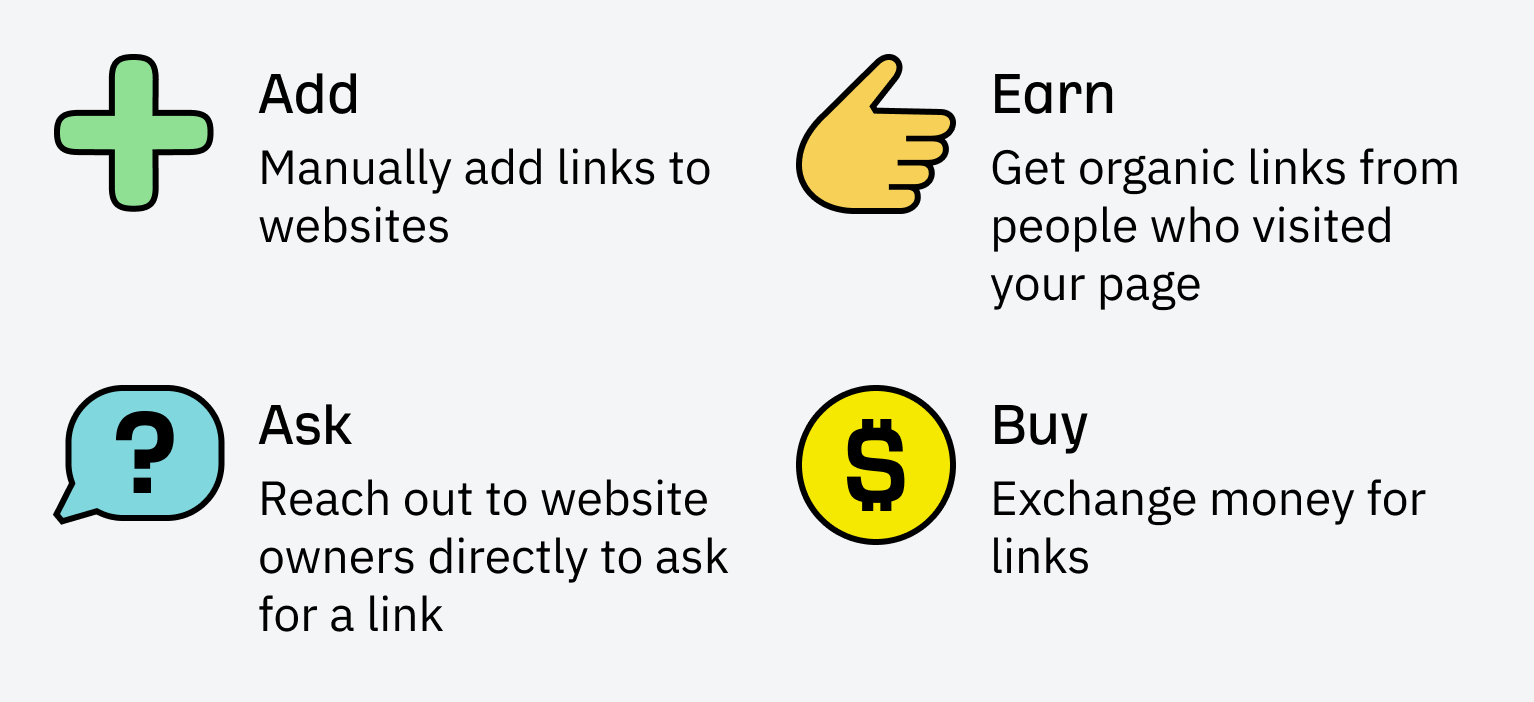
Let’s take a closer look at each of these buckets.
Certain types of websites allow their visitors to publish content on their pages with little to no moderation. Like discussion boards, for example. You can easily register at a few and post some messages with your links in them. Easy.
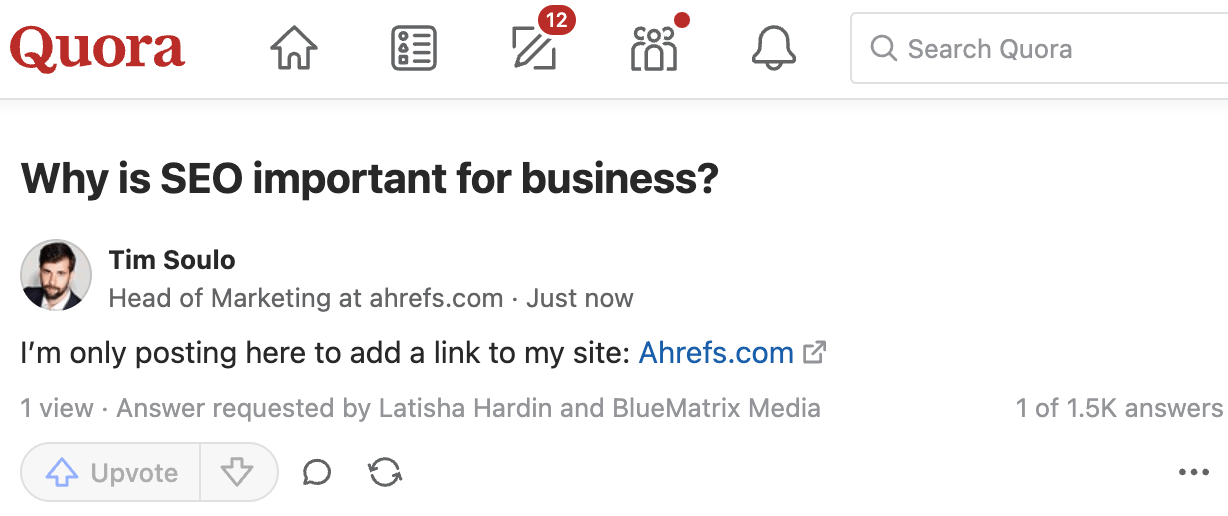
But do such links hold any value in the eyes of Google? Not really. If anyone can easily go to a website and place their link there, then links from that website won’t be seen as valuable. Plus most of the websites that allow user-generated content tend to nofollow those links anyway.
We recently hosted a link building workshop at Ahrefs HQ, and during the Q&A one lady asked me about using some WordPress plugin that automatically created backlinks (at some dubious websites) whenever she published a new post. Well, when backlinks are automatically created for you by some software—that is not link building, it’s just SPAM.
Take my advice and don’t waste your time on these kinds of link building tactics.
The links that you earn naturally are generally the best links you can get. And they’re also the hardest to get, because for that to happen you need to create something really notable on your website.
Remember I mentioned how a marketing agency got a link from our very homepage? Well, that’s a 100% earned link. They created a very detailed and thorough industry report by surveying a few hundred top SEO professionals, and some of their findings were so much in favor of Ahrefs that we couldn’t help but brag about them right on our homepage:
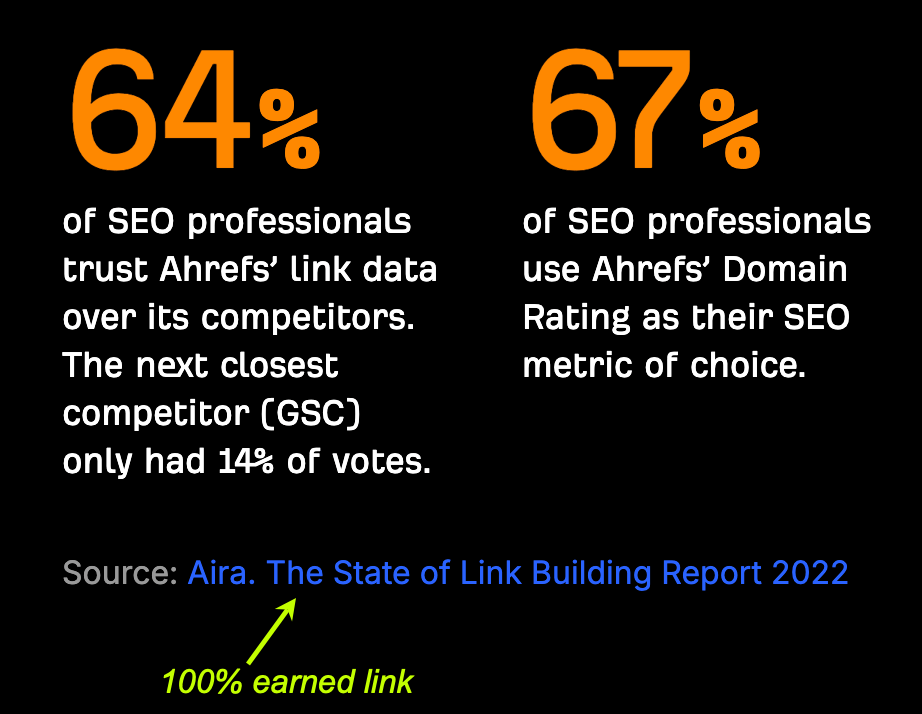
In SEO we call this link building tactic “ego bait”—their content appealed to our ego, so we wanted to promote it to more people. But we weren’t the only ones who linked to this page. There were 570 other websites that linked to it too (according to data from Ahrefs):
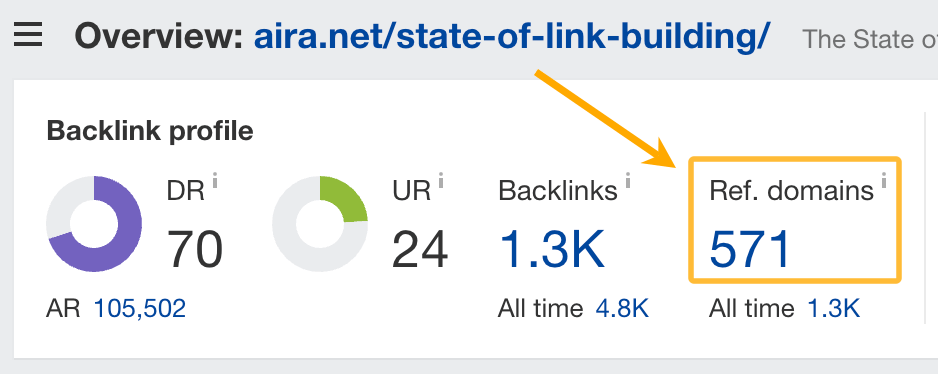
That being said, I don’t think that it was their plan to specifically egobait Ahrefs into linking to their report. But it was definitely their plan to create a piece of content so unique and valuable that a lot of people in the SEO industry would naturally link to it (earning them hundreds of quality backlinks). And if you go and study this report, you’ll see how much effort went into putting it together.
And that’s the main idea behind earning links. If you create something of high value, there’s a good chance that a lot of people will link to it naturally.
And that “value” can take many different forms:
- It could be an industry survey (like the one we linked to).
- Or an online tool (even if it’s not free).
- Or some research with interesting findings.
- Or a very thorough tutorial that solves a pressing problem.
- Or a piece of news.
We published a few articles about linkable assets and link bait which show you what it takes to create resources that people will link to. But I think that is not the advice you’re looking for right now.
It’s likely that you already have a website with many pages, and you need to build links to what you already have. Well, let’s discuss the two remaining buckets: asking for backlinks and buying them.
Let’s scroll back to the three email examples above, where some people asked me for a backlink. Do you think any of them got it?
No.
You can’t just ask a random stranger for a favor and magically get it. You have to offer them something in return. It should be an exchange of value if you want it to work. And unfortunately none of what they were offering was valuable to us.
But that doesn’t mean that “asking for backlinks” never works. You just need to work harder to make it worthwhile for the other party.
Offering a guest article is actually a very effective form of link building (when done right), because it’s a rather fair exchange of value: I contribute a great piece of content for your website and you give me a link in return. Sounds quite reasonable, right?
Well, the key to success with guest blogging lies in being able to produce really outstanding content. So if you were planning to outsource it to some cheap writer on Fiverr, or (God forbid) use an AI writing tool to churn it out—you’d have a really, really (really!) hard time finding anyone interested in publishing that lousiness on their website.
We wrote a rather detailed guide on how to do guest blogging for SEO, which will teach you how to be successful with this tactic.
But the most popular way to ask for links seems to be the Skyscraper technique. That’s where you create the “tallest” (i.e. best) piece of content on a given topic and reach out to relevant websites, asking them to link to this awesomeness.
And if you noticed a tinge of sarcasm, it’s because this technique has one gaping flaw—there’s little to no value for the recipient. Yes, you published an awesome piece of content on your website. Good for you. But why should I care? And why should I bother spending my time reviewing it, let alone linking to it?
Some people try to justify their link request with arguments like these ones:
- “It has useful information about {your_topic}.”
- “It would be a great addition to your article.”
- “It will give your readers up-to-date insights and add value to your content.”
All these lines were actually taken from a real link outreach email, that I received the other day:
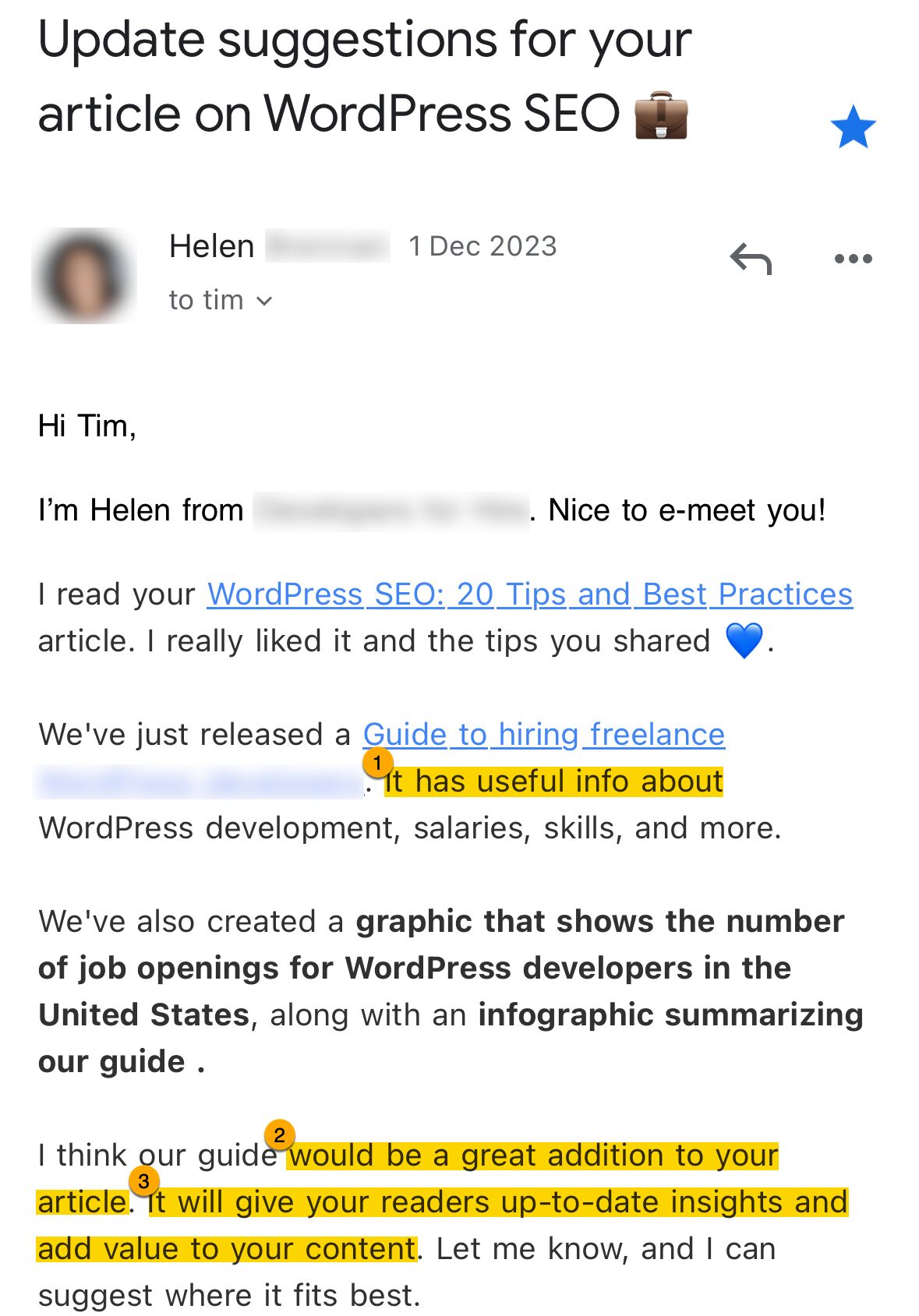
Does it sound compelling? Would you take the bait? I didn’t.
For this kind of email to work you need to have a really outstanding piece of content. Or you need to have a lot of authority in the field. Or both.
I mean, I carried out my own link outreach campaign a couple of years ago using that exact tactic. And out of 111 emails I managed to land 19 backlinks. Which was a surprisingly good result—17% success rate (usually anything above 10% is considered amazing).
Well, the truth is, most of these links came from people who were fans of Ahrefs.

Yes, I had a pretty solid article to promote. I also spent a ton of time finding the most relevant link prospects. And I carefully personalized each of my outreach emails.
But at the end of the day it was Ahrefs’ brand that did the bulk of the job. If I was doing it for a new website my success rate would easily be 2-3x lower.
What I’m trying to say is that “my page is awesome and therefore you should link to it” is a pretty weak argument. It’s not an exchange of value, you’re just asking someone for a favor. So you should not expect a high success rate from it. You’re lucky if you get 5 links from 100 emails. It’s basically a hustle.
In that regard, offering a guest post or a link exchange tends to work a lot better. But you should be very careful with those two things, as both of them are listed under “link spam” in Google’s guidelines.
Some link builders figured out that an “indirect” (also called “three-way”) link exchange is a much safer tactic than a direct one. But even that can lead you into trouble if you scale it too far and get too many links from dubious websites:

Publishing some guest posts at top sites in your industry and exchanging some links with your friends and partners is a fairly legit way to land a bunch of quality backlinks. But as soon as you start to scale this you’re risking a Google penalty. So please be careful to not overdo it.
Buying backlinks is risky. Here at Ahrefs we generally advise people against buying (or selling) backlinks. And yet many people in the SEO industry do it and manage to get away with it.
That being said, I know from experience that some of you would take the risk and try buying backlinks. So let me give you a few bits of advice, which will help you make better decisions.
First of all, never buy backlinks from those random spam emails. “We sell quality relevant high-DR backlinks from authority websites… Bla-bla-bla.”—I’m sure you’ve received offers like that. Keep away from them.

Secondly, the safest backlinks to buy are from websites that don’t sell them. If you offer someone to buy a backlink and they easily agree (or even send you a price list with options)—that’s a red flag. Legit sites don’t sell backlinks. And you want to get backlinks from legit sites only.
This means that the backlink should come as a side benefit of some broader business interaction. For example, you sponsor an event and you request to be listed as a sponsor on their website. That’s a legit backlink in my book.
I was recently helping a startup founder whose website SEO traffic tanked to zero. “It can’t be because of backlinks,” he told me. “We buy only the good ones, the expensive ones. And we added just over a thousand of them last month.”
Wow! So many red flags!
- Buying backlinks? That already can’t be good.
- Buying a thousand of them in one month? Getting even worse.
- Expensive ones? It turned out they were paying $3 per link. That’s not expensive. Not even dirt cheap. It’s practically peanuts.
I’m 99% certain that his website got a penalty because of thousands of spammy backlinks that they bought. When we did some polling of the link industry, the average price of a decent backlink hovered around $200–300. And even when you’re paying a premium, there’s no guarantee that you won’t get scammed.
That being said, I’d like to absolve myself of all responsibility for the outcomes of the above advice. Buying links is always risky, and it’s just too easy to buy them from a “bad neighborhood” if you’re not experienced enough. So don’t blame me if you get a penalty from Google.
But there’s one more way to exchange money for backlinks, which is quite safe and effective. You can pay agencies and freelancers to build them for you.
Guest posting, Skyscraper technique, partnerships and link exchanges—all of these things can be done for you by professionals. And if you hire the right folks, they will make sure to avoid anything too risky and keep your website safe. Just make sure you ask them for examples of their previous work and request to talk to their past clients.
Remember I said that earning links is the best strategy of all? Well, a seasoned SEO professional might help you create outstanding content that would attract a lot of backlinks naturally. It can be quite expensive, but it’s totally worth it.
All in all, if you don’t plan to make a career in SEO, it is probably a good idea to outsource link building to professionals, rather than do it yourself.
So now you know the theory behind building backlinks. But nothing beats rolling up your sleeves and getting your hands dirty. And there’s no better place to start than researching where your competitors got their backlinks from.
For that, you’ll need access to Ahrefs (or at least our free Backlink Checker tool).
The homepages of your competitors’ websites are a great source of link opportunities (and inspiration).
Just plug your competitor’s homepage URL into Ahrefs Site Explorer (make sure to set it to “Exact URL” mode) and navigate to the report called “Backlinks”:
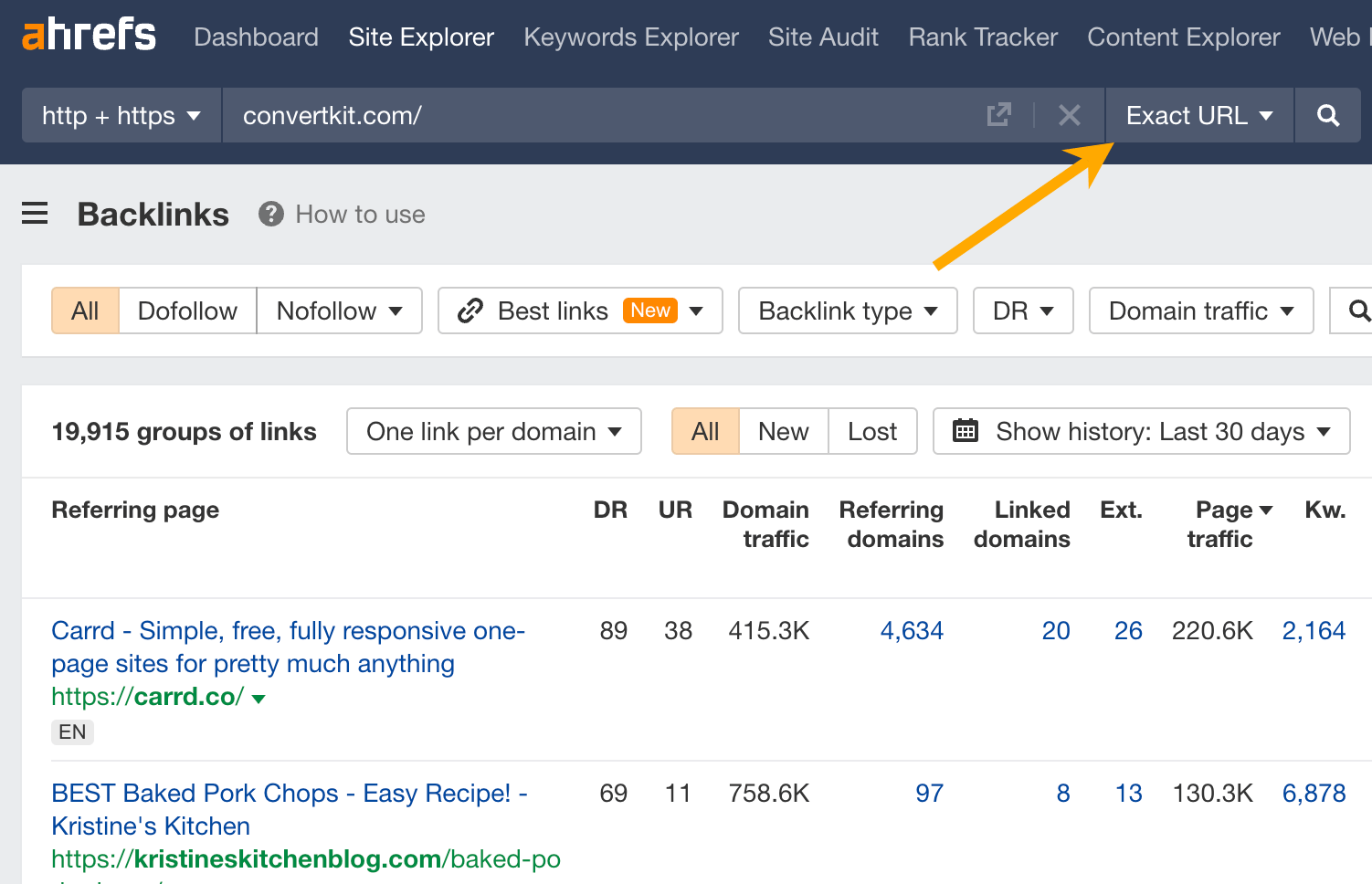
I did that with the homepage of Convertkit, which is an email marketing software. And the very first link that I saw in the report was quite interesting. It is coming from Carrd—a software for building one-page websites. They seem to be listing all the email tools that they integrate with right on their homepage, and Convertkit is one of them:
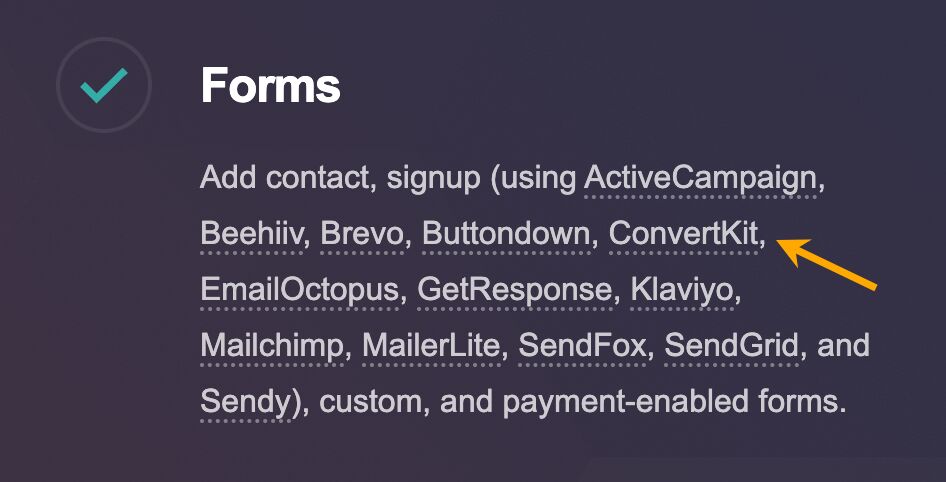
So if I were building links for some email marketing software, I could potentially get listed on the homepage of Carrd, too. But I would need to develop the same kind of integration to make it happen. And from there I could probably look for more integration opportunities with other tools, which might result in more links from other websites.
That’s how you study the homepage links of your competitors and use that information to get the same (or similar) links for your own website.
There’s a good chance that your competitors have a bunch of cool resources on their websites that have earned them thousands of high-quality links.
Well, you can easily see any website’s “most linked pages” with the help of Ahrefs Site Explorer. The report you’re looking for is called “Best by links”:
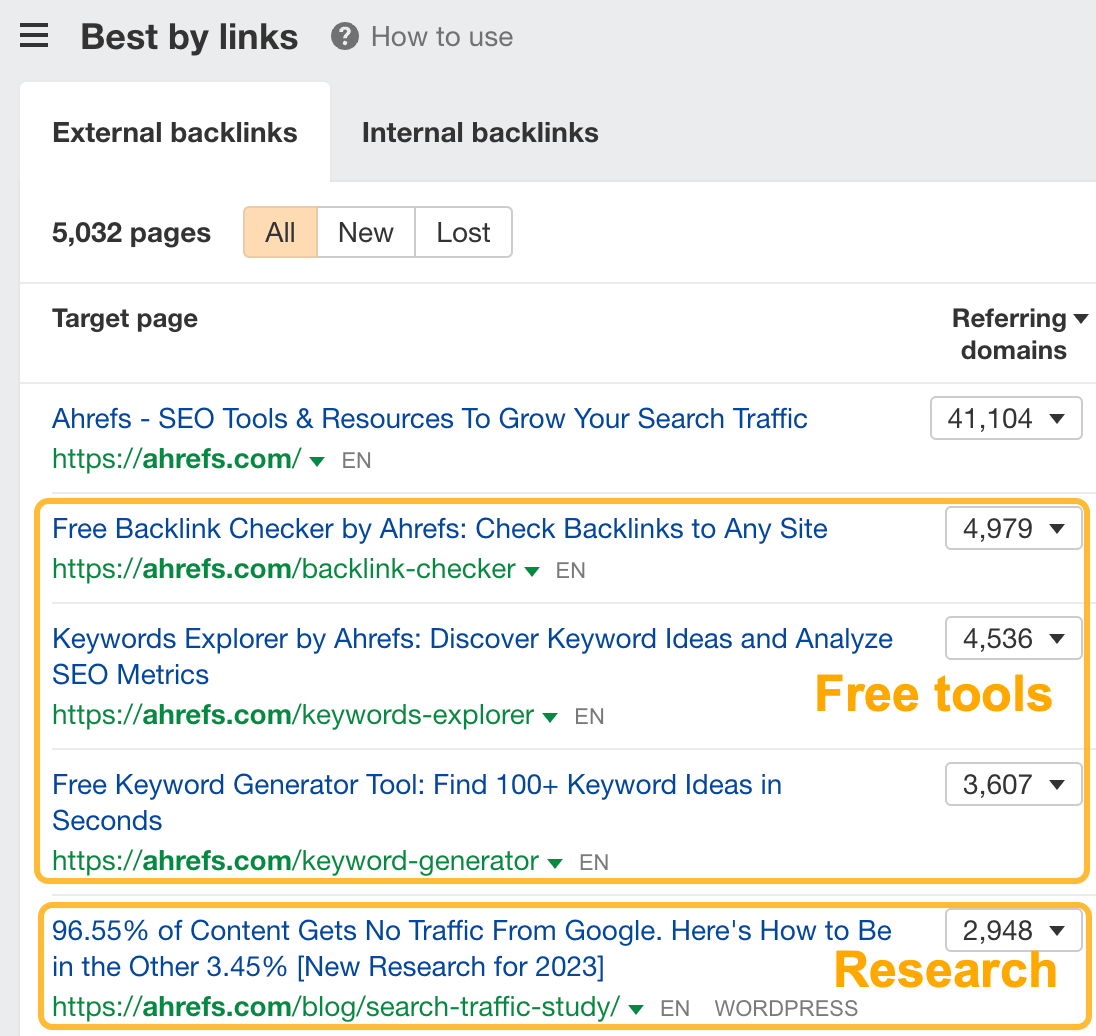
From the screenshot above you can see that the top three most linked pages on our own website are free online tools. I must say that building free tools is a rather safe bet in terms of creating linkable assets. People love free tools that help them perform a certain task and they eagerly link to them from their websites.
The next most linked page is a research study. Whenever you can carry out an interesting experiment or get your hands on some unique data and derive useful insights from it, you’ll end up with a pretty compelling linkable asset. (And if you think that you don’t have any interesting data at your disposal, I suggest you read the “Content Marketing Handbook by Priceonomics”—it should give you some good ideas of where to look for it.)
Creating linkable assets is not easy. But if your competitors have them and you don’t, you’re at a huge disadvantage. As you hustle to get each of your backlinks, they will be getting theirs on near autopilot. So I strongly recommend that you don’t skip this step and invest some effort into creating a few solid linkable assets on your website.
In the first two steps we focused on building backlinks to your website as a whole. This leads to the boost of your overall “website authority” and helps all the pages of your website to rank better in Google.
But eventually you’ll need to shift your attention to a number of very specific pages that you need to rank for very specific keywords. How do you get backlinks to those?
Well, why don’t you look at where the pages that currently rank at the top for your desired keyword got their backlinks from?
Let’s say you want to rank for a search query “best burgers in Singapore.” If you put this keyword in Ahrefs Keywords Explorer, the SERP Overview widget will show you the top-ranking pages and how many backlinks they currently have:
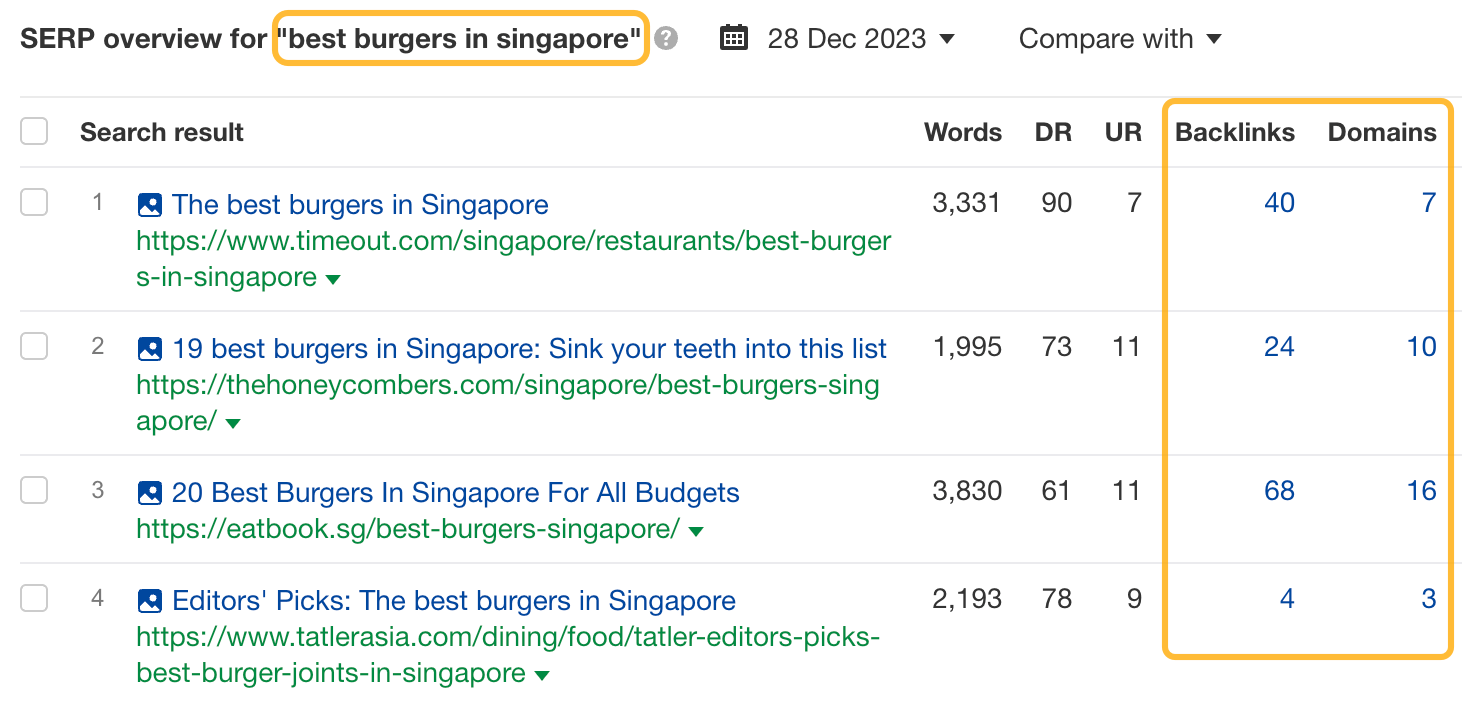
From there you can click on any of these numbers, and you will be redirected to the respective report in Site Explorer with a list of backlinks (or referring domains) for a given page.
I did this with a page that ranks #2 and found a very interesting backlink:
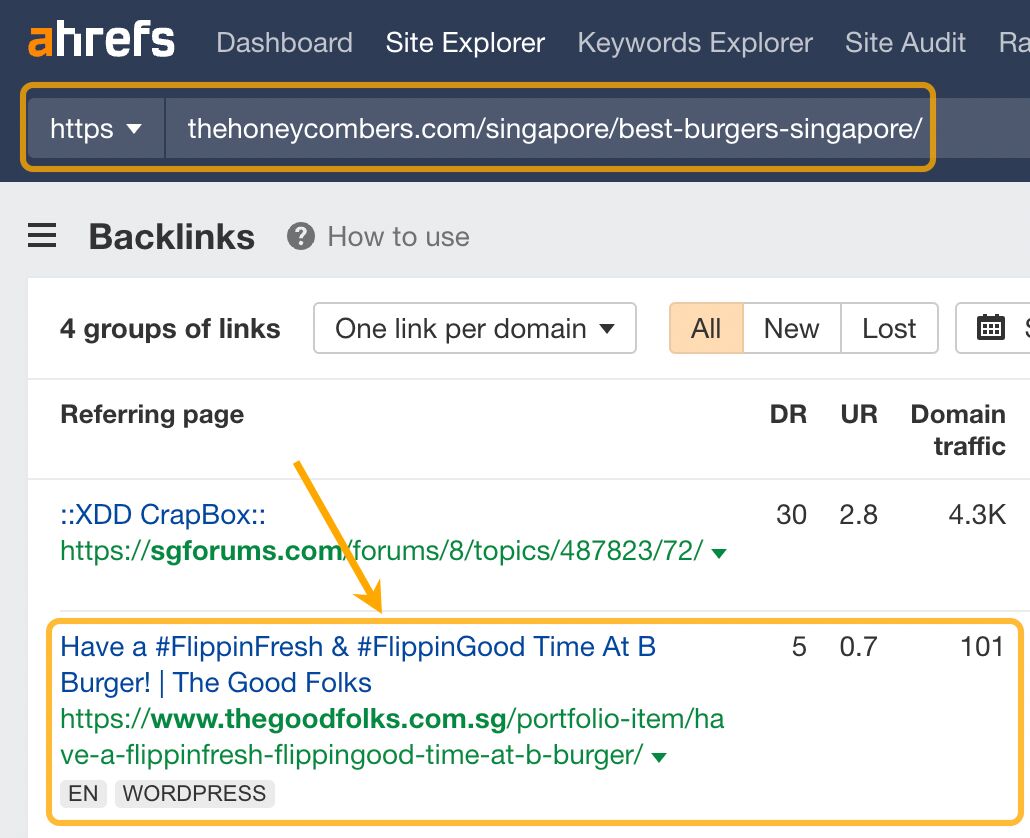
This is a page on the website of a burger joint, where they’re listing all the local websites that featured their burgers:
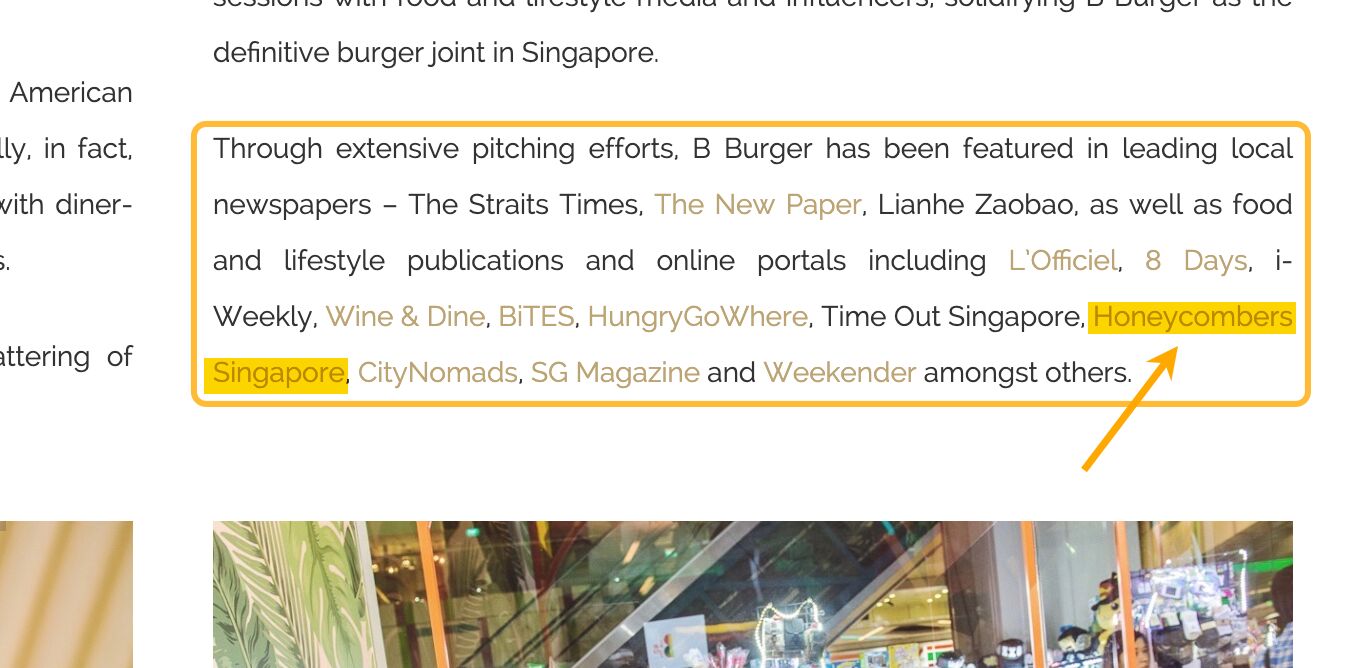
This lead me to think that if I wanted my page to rank in Google for “best burgers in Singapore,” I would probably need to leverage egobait as my primary link building tactic. I would create a bunch of different awards (best burger overall, best wagyu burger, best burger under $15, best burger menu, best chicken burger, best vegan burger, etc.) and then I would reach out to respective restaurants and let them know that they won an award in a given category, asking them to mention it somewhere on their website… and link to my page.
This is a good illustration of how studying the exact pages that you want to outrank can lead to useful insights on how to get links to your own page on the same topic.
And if you’re super new to link building and you struggle to find patterns and come up with ideas—just reach out to websites that link to your competitors and flat-out ask them what made them link to a given page. Maybe there’s some broader partnership happening behind the scenes that you aren’t aware of.
Good luck getting backlinks!
So there it is. As you can probably tell by now, building legit backlinks isn’t easy. But that is actually the whole point.
A lot of people are looking for shortcuts in link building. They’re trying to find ways to get lots of backlinks without investing much effort. But that is only good for getting your website penalized.
You’ll be much better off if you embrace the fact that getting links is not some technical process that can be hacked or exploited. You’re essentially dealing with other humans. So focusing on how to impress them with your content, and how to deserve their praise, is a much healthier mindset than trying to trick them into linking to you when you don’t deserve it.



